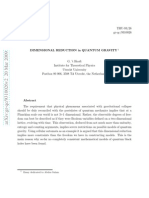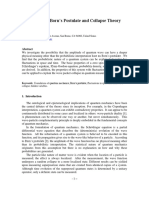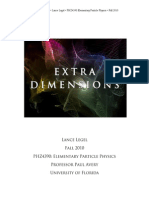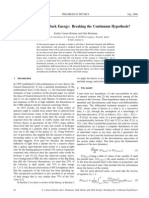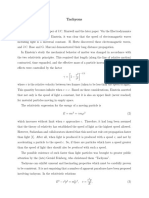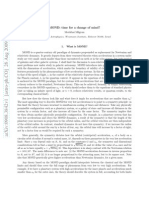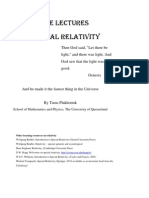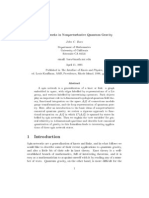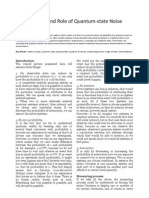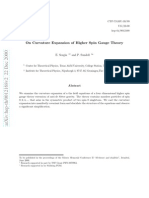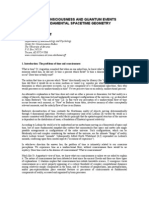On The Dimensionality of Space Time
On The Dimensionality of Space Time
Uploaded by
nikesemperCopyright:
Available Formats
On The Dimensionality of Space Time
On The Dimensionality of Space Time
Uploaded by
nikesemperOriginal Title
Copyright
Available Formats
Share this document
Did you find this document useful?
Is this content inappropriate?
Copyright:
Available Formats
On The Dimensionality of Space Time
On The Dimensionality of Space Time
Uploaded by
nikesemperCopyright:
Available Formats
Class. Quantum Grav. 14 (1997) L69L75.
Printed in the UK
PII: S0264-9381(97)81824-2
LETTER TO THE EDITOR
On the dimensionality of spacetime
Max Tegmark
Institute for Advanced Study, Olden Lane, Princeton, NJ 08540, USA Received 10 February 1997 Abstract. Some superstring theories have more than one effective low-energy limit corresponding to classical spacetimes with different dimensionalities. We argue that all but the (3 + 1)-dimensional one might correspond to dead worlds, devoid of observers, in which case all such ensemble theories would actually predict that we should nd ourselves inhabiting a (3 + 1)-dimensional spacetime. With more or less than one time dimension, the partial differential equations of nature would lack the hyperbolicity property that enables observers to make predictions. In a space with more than three dimensions, there can be no traditional atoms and perhaps no stable structures. A space with less than three dimensions allows no gravitational force and may be too simple and barren to contain observers. PACS numbers: 1125M, 0420G
Many superstring theories have several stable (or extremely long-lived) states that constitute different effective low-energy theories with different spacetime dimensionalities, corresponding to different compactications of the many (e.g. 11 or 26) dimensions of the fundamental manifold. Since the tunnelling probabilities between these states are negligible, such a theory for all practical purposes predicts an ensemble of classical (n+m)dimensional spacetimes, and the prediction for the dimensionality takes the form of a probability distribution over n and m [1]. There are also inationary models predicting a universe consisting of parts of exponentially large size having different dimensionality [2]. In this paper, we argue that this failure to make the unique prediction (n, m) = (3, 1) is not a weakness of such theories, but a strength. To compute the theoretically predicted probability distribution for the dimensionality of our spacetime, we clearly need to take into account the selection effect arising from the fact that some of these states are more likely to contain self-aware observers such as us than others. This is completely analogous to the familiar selection effect in cosmological galaxy surveys, where we must take into account that bright galaxies are more likely to be sampled than faint ones [3]. Below we will argue that if observers can only exist in a world exhibiting a certain minimum complexity, predictability and stability, then all such ensemble theories may actually predict that we should nd ourselves inhabiting a (3 + 1)-dimensional spacetime with 100% certainty, as illustrated in gure 1, and that the Bayesian prior probabilities of quantum-mechanical origin are completely irrelevant. We will rst review some old but poorly known results regarding the number of spatial dimensions (when m = 1), then present some new arguments regarding
E-mail address: max@ias.edu Hereafter, we let n and m refer to the number of non-compactied space and time dimensions, or more generally to the effective spacetime dimensionality that is relevant to the low-energy physics we will be discussing later. 0264-9381/97/040069+07$19.50 c 1997 IOP Publishing Ltd
L69
L70
Letter to the Editor
Figure 1. When the partial differential equations of nature are elliptic or ultrahyperbolic, physics has no predictive power for an observer. In the remaining (hyperbolic) cases, n > 3 may fail on the stability requirement (atoms are unstable) and n < 3 may fail on the complexity requirement (no gravitational attraction, topological problems). (This gure can be viewed in colour in the electronic version of the article; see http://www.iop.org/EJ/welcome)
the number of time dimensions. In both cases, we are not attempting to rigorously show that merely (n, m) = (3, 1) permits observers. Rather, we are simply arguing that it is far from obvious that any other (n, m) permits observers, since radical qualitative changes occur in all cases, so that the burden of proof of the contrary falls on the person wishing to criticize ensemble theories with ne-tuning arguments. As was pointed out by Ehrenfest back in 1917 [4], neither classical atoms nor planetary orbits can be stable in a space with n > 3, and traditional quantum atoms cannot be stable either [5]. These properties are related to the fact that the fundamental Greens function of the Poisson equation 2 = , which gives the electrostatic/gravitational potential of a point particle, is r 2n for n > 2. Thus, the inverse-square law of electrostatics and gravity becomes an inverse-cube law if n = 4, etc. When n > 3, the two-body problem no longer has any stable orbits as solutions [6]. This is illustrated in gure 2, where a swarm of light test particles are incident from the left on a massive point particle (the black dot), all with the same momentum vector but with a range of impact parameters. There are two cases: those that start outside the shaded region escape to innity, whereas those with smaller impact parameters spiral into a singular collision in a nite time. We can think of this as there being a nite cross section for annihilation. This is of course in stark contrast to the familiar case, n = 3, which gives either stable elliptic orbits or non-bound parabolic and hyperbolic orbits, and has no annihilation solutions except for the measure
Letter to the Editor
L71
Figure 2. The-two body problem in four-dimensional space: the light particles that approach the heavy one at the centre either escape to innity or get sucked into a cataclysmic collision. There are no stable orbits. (This gure can be viewed in colour in the electronic version of the article; see http://www.iop.org/EJ/welcome)
zero case where the impact parameter is exactly zero. A similar disaster occurs in quantum mechanics, where a study of the Schr dinger equation shows that the hydrogen atom has o no bound states for n > 3 [5]. Again, there is a nite annihilation cross section, which is reected by the fact that the hydrogen atom has no ground state, but time-dependent states of arbitrarily negative energy. The situation in general relativity is analogous [5]. Modulo the important caveats in the discussion section, this means that such a world cannot contain any objects that are stable over time, and thus probably cannot contain stable observers. What about n < 3? It has been argued [7] that organisms would face insurmountable topological problems if n = 2: for instance, two nerves cannot cross. Another problem, emphasized by Wheeler et al [8], is the well known fact (see e.g. [9]) that there is no gravitational force in general relativity with n < 3. We will not spend more time listing problems with n < 3, but simply conjecture that since n = 2 (let alone n = 1 and n = 0) offers vastly less complexity than n = 3, worlds with n < 3 are just too simple and barren to contain observers. Here, we will present an argument for why a world with the same laws of physics as ours and with an (n+m)-dimensional spacetime can only contain observers if the number of time dimensions m = 1, regardless of the number of space dimensions, n. Before describing this argument, which involves hyperbolicity properties of partial differential equations (PDEs), let us make a few general comments about the dimensionality of time. What would reality appear like to an observer in a manifold with more than one time-like dimension? Even when m > 1, there is no obvious reason why an observer could not, none the less, perceive time as being one-dimensional, thereby maintaining the pattern of having thoughts in a one-dimensional succession that characterizes our own reality perception. If the observer is a localized object, it will travel along an essentially one-dimensional (timelike) world line through the (n + m)-dimensional spacetime manifold. The standard general relativity notion of its proper time is perfectly well dened, and we would expect this to be the time that it would measure if it had a clock and that it would subjectively experience.
L72
Letter to the Editor
Needless to say, many aspects of the world would none the less appear quite different. For instance, a re-derivation of relativistic mechanics for this more general case shows that energy now becomes an m-dimensional vector rather than a constant, whose direction determines in which of the many time directions the world line will continue, and in the non-relativistic limit, this direction is a constant of motion. In other words, if two nonrelativistic observers that are moving in different time directions happen to meet at a point in spacetime, they will inevitably drift apart in separate time directions again, unable to stay together. Another interesting difference, which can be shown by an elegant geometrical argument [10], is that particles become less stable when m > 1. For a particle to be able to decay when m = 1, it is not sufcient that a set of particles with the same quantum numbers exists. It is also necessary, as is well known, that the sum of their rest masses should be less than the rest mass of the original particle, regardless of how great its kinetic energy may be. When m > 1, this constraint vanishes [10]. For instance, a proton can decay into a neutron, a positron and a neutrino, an electron can decay into a neutron, an antiproton and a neutrino, and a photon of sufciently high energy can decay into any particle and its antiparticle. In addition to these two differences, one can concoct seemingly strange occurrences involving backward causation when m > 1. None the less, although such unfamiliar behaviour may appear disturbing, it would seem unwarranted to assume that it would prevent any form of observer from existing. After all, we must avoid the fallacy of assuming that the design of our human bodies is the only one that allows self-awareness. Electrons, protons and photons would still be stable if their kinetic energies were low enough, so perhaps observers could still exist in rather cold regions of a world with m > 1. There is, however, an additional problem for observers when m > 1, which has not been previously emphasized even though the mathematical results on which it is based are well known. If an observer is to be able to make any use of its self-awareness and information-processing abilities, the laws of physics must be such that it can make at least some predictions. Specically, within the framework of a eld theory, it should, by measuring various nearby eld values, be able to compute eld values at some more distant spacetime points (ones lying along its future world line being particularly useful) with noninnite error bars. If this type of well-posed causality were absent, then not only would there be no reason for observers to be self-aware, but it would appear highly unlikely that information processing systems (such as computers and brains) could exist at all. Although this predictability requirement may sound modest, it is in fact only met by a small class of PDEs, essentially those which are hyperbolic. We will now discuss the classication and causal structure of PDEs in some detail. This mathematical material is well known, and can be found in more detail in [12]. Given an arbitrary second-order linear partial differential equation in Rd ,
d d
Aij
i=1 j =1
+ xi xj
d i=1
bi
+ c u = 0, xi
(1)
where the matrix A (which we, without loss of generality, can take to be symmetric), the vector b and the scalar c are given differentiable functions of the d coordinates, it is customary to classify it depending on the signs of the eigenvalues of A. The PDE is said to be elliptic in some region of Rd if they are all positive or all negative there,
It is, however, far from trivial to formulate a quantum eld theory with a stable vacuum state when m > 1 [11].
Letter to the Editor
L73
hyperbolic if one is positive and the rest are negative (or vice versa), and ultrahyperbolic in the remaining case, i.e. where at least two eigenvalues are positive and at least two are negative. What does this have to do with the dimensionality of spacetime? For the various covariant eld equations of nature that describe our world (the wave equation u; = 0, the KleinGordon equation u; + m2 u = 0, etc), the matrix A will clearly have the same eigenvalues as the metric tensor. For instance, they will be hyperbolic in a metric of the signature (+ ), corresponding to (n, m) = (3, 1), elliptic in a metric of the signature (+ + + + +), and ultrahyperbolic in a metric of the signature (+ + ). One of the merits of this standard classication of PDEs is that it determines their causal structure, i.e. how the boundary conditions must be specied to make the problem wellposed. Roughly speaking, the problem is said to be well-posed if the boundary conditions determine a unique solution, u, and if the dependence of this solution on the boundary data (which will always be linear) is bounded. The last requirement means that the solution u at a given point will only change by a nite amount if the boundary data is changed by a nite amount. Therefore, even if an ill-posed problem can be formally solved, this solution would in practice be useless to an observer, since it would need to measure the initial data with innite accuracy to be able to place nite error bars on the solution (any measurement error would cause the error bars on the solution to be innite). Elliptic equations allow well-posed boundary value problems. On the other hand, giving initial data for an elliptic PDE on a non-closed hypersurface, say a plane, is an ill-posed problem. This means that an observer in a world with no time dimensions (m = 0) would not be able do make any inferences at all about the situation in other parts of space based on what it observes locally. Hyperbolic equations, on the other hand, allow well-posed initial-value problems. For example, specifying initial data (u and u) for the KleinGordon equation on the shaded disk in gure 3 determines the solution in the volumes bounded by the two cones, including the (missing) tips. A localized observer can therefore make predictions about its future. If the matter under consideration is of such a low temperature that it is non-relativistic, then the elds will essentially contain only Fourier modes with wavenumbers |k| m, which means that for all practical purposes, the solution at a point is determined by the initial data in a causality cone with an opening angle much narrower than 45 . In contrast, if the initial data for a hyperbolic PDE is specied on a hypersurface that is not space-like, the problem becomes ill-posed. Figure 3, which is based on [12], provides an intuitive understanding of what goes wrong. A corollary of a remarkable theorem by Asgeirsson [13] is that if we specify u in the cylinder in gure 3, then this determines u throughout the region made up of the truncated double cones. Letting the radius of this cylinder approach zero, we obtain the disturbing conclusion that providing data in a, for all practical purposes, one-dimensional region determines the solution in a three-dimensional region. Such an apparent free lunch, where the solution seems to contain more information than input data, is a classical symptom of ill-posedness. The price that must be paid is specifying the input data with innite accuracy, which is of course impossible given realworld measurement errors. Clearly, generic boundary data allows no solution at all, since it is not self-consistent. It is easy to see that the same applies when specifying initial data on part of a non-space-like hypersurface, e.g. that given by y = 0. These properties are
Our discussion will apply to matter elds with spin as well, e.g. fermions and photons, since spin does not alter the causal structure of the solutions. For instance, all four components of an electronpositron eld obeying the Dirac equation satisfy the KleinGordon equation as well, and all four components of the electromagnetic vector potential in Lorentz gauge satisfy the wave equation.
L74
Letter to the Editor
Figure 3. The causality structure for hyperbolic and ultrahyperbolic equations.
analogous in n + 1 dimensions, and illustrate why an observer in an (n + 1)-dimensional spacetime can only make predictions in time-like directions. Asgeirssons theorem also applies to the ultrahyperbolic case as well, showing that initial data on a hypersurface containing both space-like and time-like directions leads to an ill-posed problem. However, since a hypersurface by denition has a dimensionality which is one less than that of the spacetime manifold (data on a submanifold of lower dimensionality can never give a well-posed problem), there are no space-like or time-like hypersurfaces in the ultrahyperbolic case, and hence no well-posed problems. Since a mere minus sign distinguishes space from time, the remaining case (n, m) = (1, 3) is mathematically equivalent to the case where (n, m) = (3, 1) and all particles are tachyons [14] with imaginary rest mass. Also in this case, an observer would be unable to make any predictions since, as described in more detail in [15], well-posed problems require data to be specied in the non-local region outside the lightcones. Above we discussed only linear PDEs, although the full system of coupled PDEs in nature is of course nonlinear. This in no way weakens our conclusions about only m = 1 giving well-posed initial-value problems. When PDEs give ill-posed problems even locally, in a small neighbourhood of a hypersurface (where we can generically approximate the nonlinear PDEs with linear ones), it is obvious that no nonlinear terms can make them well-posed in a larger neighbourhood. Our conclusions are graphically illustrated in gure 1: given the other laws of physics, it is not implausible that only a (3+1)-dimensional spacetime can contain observers that are complex and stable enough to be able to understand and predict their world to any extent at all, for the following reasons. More or less than one time dimension: insufcient predictability. More than three space dimensions: insufcient stability.
The only remaining possibility is the rather contrived case where data is specied on a null hypersurface. To measure such data, an observer would need to live on the light cone, i.e. travel with the speed of light, which means that it would subjectively not perceive any time at all (its proper time would stand still).
Letter to the Editor
L75
Less than three space dimensions: insufcient complexity. Thus, although application of the so-called weak anthropic principle [16] does in general not appear to give very strong predictions for physical constants [17], its dimensionality predictions may indeed turn out to give the narrowest probability distribution possible. Viewed in this light, the multiple dimensionality prediction of some superstring theories is a strength rather than a weakness, since it eliminates the otherwise embarrassing discrete ne-tuning problem of having to explain the lucky coincidence that the compactication mechanism itself happened to single out only a (3 + 1)-dimensional spacetime. Needless to say, we have not attempted to rigorously demonstrate that observers are impossible for other dimensionalities. For instance, within the context of specic models, one might consider exploring the possibility of stable structures in the case (n, m) = (4, 1) based on short distance quantum corrections to the 1/r 2 potential or on string-like (rather than point-like) particles. We have simply argued that it is far from obvious that any other combination other than (n, m) = (3, 1) permits observers, since radical qualitative changes occur when n or m are altered. For this reason, a theory cannot be criticized for failing to predict a denite spacetime dimensionality until the stability and predictability issues raised here have been carefully analysed. The author wishes to thank Andreas Albrecht, Dieter Maison, Harold Shapiro, John A Wheeler, Frank Wilczek and Edward Witten for stimulating discussions on some of the above-mentioned topics. References
[1] [2] [3] [4] [5] [6] [7] [8] [9] [10] [11] [12] [13] [14] [15] [16] Albrecht A 1994 The Birth of the Universe and Fundamental Forces ed F Occionero (Berlin: Springer) Linde A D and Zelnikov M I 1988 Phys. Lett. 215B 59 Vilenkin A 1995 Phys. Rev. Lett. 74 846 Ehrenfest P 1917 Proc. Amsterdam Acad. 20 200 Tangherlini F R 1963 Nuovo Cimento 27 636 B chel W 1963 Physikalische Bl tter 19 547 u a Freeman I M 1969 Am. J. Phys. 37 1222 Whitrow C J 1955 Brit. J. Phil. 6 13 Misner C W, Thorne K S and Wheeler J A 1973 Gravitation (San Francisco, CA: Freeman) p 1205 Deser S, Jackiw R and THooft G 1984 Ann. Phys. 152 220 Dorling J 1969 Am. J. Phys. 38 539 Linde A D 1990 Particle Physics and Inationary Cosmology (Chur, Switzerland: Harwood) p 318 Courant R and Hilbert D 1962 Methods of Mathematical Physics (New York: Interscience) Asgeirsson L 1936 Math Ann. 113 321 Feinberg G 1967 Phys. Rev. 159 1089 Tegmark M 1996 Preprint Carter B 1974 IAU Symposium 63 ed S Longair (Dordrecht: Reidel) Barrow J D and Tipler F J 1986 The Anthropic Cosmological Principle (Oxford: Clarendon) Balashov Y V 1991 Am. J. Phys. 59 1069 Greenstein G and Kropf A 1989 Am. J. Phys. 57 746
[17]
You might also like
- 6th Central Pay Commission Salary CalculatorDocument15 pages6th Central Pay Commission Salary Calculatorrakhonde100% (436)
- 6th Central Pay Commission Salary CalculatorDocument15 pages6th Central Pay Commission Salary Calculatorrakhonde100% (436)
- 6th Central Pay Commission Salary CalculatorDocument15 pages6th Central Pay Commission Salary Calculatorrakhonde100% (436)
- Alvin Goldman - Readings in Philosophy and Cognitive ScienceDocument742 pagesAlvin Goldman - Readings in Philosophy and Cognitive SciencenikesemperNo ratings yet
- Pioneering Quantum GravityDocument11 pagesPioneering Quantum Gravitytanishqkumar0422No ratings yet
- Essay Dedicated To Abdus SalamDocument13 pagesEssay Dedicated To Abdus SalamMrBlueAlienNo ratings yet
- Quantum FoamDocument20 pagesQuantum FoamAnonymous yjF4yygpPbNo ratings yet
- Bedingham Et Al. - 2014 - Matter Density and Relativistic Models of Wave Function CollapseDocument9 pagesBedingham Et Al. - 2014 - Matter Density and Relativistic Models of Wave Function CollapseBeto CarreñoNo ratings yet
- How Retrocausality Helps: Rod - Sutherland@sydney - Edu.auDocument7 pagesHow Retrocausality Helps: Rod - Sutherland@sydney - Edu.auCamilo Andrés VargasNo ratings yet
- tmpB89E TMPDocument19 pagestmpB89E TMPFrontiersNo ratings yet
- The Matter-Wave Background of Titius-Bode RuleDocument6 pagesThe Matter-Wave Background of Titius-Bode RuleDezso SarkadiNo ratings yet
- The Information Paradox A Pedagogical Introduction CernDocument38 pagesThe Information Paradox A Pedagogical Introduction CerntechnoversalgeekNo ratings yet
- Cosmology and New Physics: Elementary Particles and Fields TheoryDocument20 pagesCosmology and New Physics: Elementary Particles and Fields TheorysevensixtwoNo ratings yet
- Everpresent LambaDocument10 pagesEverpresent LambahypercubicityNo ratings yet
- Reginald T. Cahill - Black Holes and Quantum Theory: The Fine Structure Constant ConnectionDocument7 pagesReginald T. Cahill - Black Holes and Quantum Theory: The Fine Structure Constant ConnectionPortsnuyhNo ratings yet
- Joe's Little Book of String Class Notes, Phys 230A, String Theory, Winter 2010Document90 pagesJoe's Little Book of String Class Notes, Phys 230A, String Theory, Winter 2010Nelson Mechán ZuritaNo ratings yet
- To What Extent Does String Theory Provide A 'Theory of Everything'?Document4 pagesTo What Extent Does String Theory Provide A 'Theory of Everything'?miaherkanaiduNo ratings yet
- Andrei LindeDocument35 pagesAndrei LindeJordi FornerNo ratings yet
- Thesis Quantum GravityDocument6 pagesThesis Quantum Gravityrajeedentfargo100% (1)
- A Dark Energy Model Characterized by The Age of The UniverseDocument4 pagesA Dark Energy Model Characterized by The Age of The UniverseRigel Kun AgueroNo ratings yet
- 1 Quantum Gravity, Who Needs It?!: 1.1 UnificationDocument24 pages1 Quantum Gravity, Who Needs It?!: 1.1 UnificationAhmedKhalifaNo ratings yet
- 0305206Document5 pages0305206nom nomNo ratings yet
- Theory of GravityDocument6 pagesTheory of GravityKyle ByrneNo ratings yet
- Life in 2+1 DimensionsDocument22 pagesLife in 2+1 DimensionsRichard WagnerNo ratings yet
- The Cosmological Constant Stephen HawkingDocument9 pagesThe Cosmological Constant Stephen HawkingikutmilisNo ratings yet
- Intro FieldsDocument28 pagesIntro FieldsGerman ChiappeNo ratings yet
- 3compatibility of Quantum Mechanics and General RelativityDocument4 pages3compatibility of Quantum Mechanics and General RelativityIshan VatsaNo ratings yet
- Traschen J. - An Introduction To Black Hole EvaporationDocument33 pagesTraschen J. - An Introduction To Black Hole EvaporationKhem UpathambhakulNo ratings yet
- The VSL Discussion: What Does Variable Speed of Light Mean and Should We Be Allowed To Think About ?Document4 pagesThe VSL Discussion: What Does Variable Speed of Light Mean and Should We Be Allowed To Think About ?muffinmule4No ratings yet
- T'hooft HorizonsDocument15 pagesT'hooft Horizonsaud_philNo ratings yet
- Emergent SpacetimeDocument10 pagesEmergent SpacetimeArun NandaNo ratings yet
- Heisenberg, "Über Den Anschaulichen Inhalt Der Quantentheoretischen Kinematik Und Mechanik"Document16 pagesHeisenberg, "Über Den Anschaulichen Inhalt Der Quantentheoretischen Kinematik Und Mechanik"Benjamin Crowell50% (2)
- Cosmic Dark Energy Emerging From Gravitationally Effective Vacuum FluctuationsDocument11 pagesCosmic Dark Energy Emerging From Gravitationally Effective Vacuum FluctuationsarmandosanoNo ratings yet
- Extra Dimensions - Lance Legel - PHZ4390 Elementary Particle Physics - Fall 2010Document18 pagesExtra Dimensions - Lance Legel - PHZ4390 Elementary Particle Physics - Fall 2010Lance LegelNo ratings yet
- Mit8 323 s23 Rec01Document8 pagesMit8 323 s23 Rec01Origami TutorialsNo ratings yet
- Emilio Casuso Romate and John Beckman - Dark Matter and Dark Energy: Breaking The Continuum Hypothesis?Document5 pagesEmilio Casuso Romate and John Beckman - Dark Matter and Dark Energy: Breaking The Continuum Hypothesis?AzmerzrNo ratings yet
- Quantum PhysicsDocument20 pagesQuantum PhysicsViskersNo ratings yet
- Consistent Probabilities in Loop Quantum Cosmology 1306.6142Document22 pagesConsistent Probabilities in Loop Quantum Cosmology 1306.6142forizslNo ratings yet
- Wiltshire - An Introduction To Quantum CosmologyDocument60 pagesWiltshire - An Introduction To Quantum CosmologyTayavek ReynosoNo ratings yet
- Combining General Relativity and Quantum Theory: Points of Conflict and ContactDocument16 pagesCombining General Relativity and Quantum Theory: Points of Conflict and ContactArish AhmedNo ratings yet
- Entropy: Modeling Time's ArrowDocument16 pagesEntropy: Modeling Time's ArrowHsiung TzeNo ratings yet
- Dynamics and Relativity: University of Cambridge Part IA Mathematical TriposDocument164 pagesDynamics and Relativity: University of Cambridge Part IA Mathematical TriposrasromeoNo ratings yet
- Windows On The Universe - PeeblesDocument6 pagesWindows On The Universe - PeeblesluitnoiNo ratings yet
- Losing Forward Momentum Holographically: YITP-SB-13-44Document42 pagesLosing Forward Momentum Holographically: YITP-SB-13-44crocoaliNo ratings yet
- Pioneering Quantum GravityDocument9 pagesPioneering Quantum Gravitytanishqkumar0422No ratings yet
- RelativityDocument32 pagesRelativityCineva CindvaNo ratings yet
- Gao, Shan (2013) Three Possible Implications of Spacetime DiscretenessDocument17 pagesGao, Shan (2013) Three Possible Implications of Spacetime DiscretenessTommaso CiminoNo ratings yet
- List of Unsolved Problems in PhysicsDocument11 pagesList of Unsolved Problems in Physicsdraganscribd12No ratings yet
- TachyonsDocument3 pagesTachyonsMUHAMMED KHANNo ratings yet
- MOND: Time For A Change of Mind?Document12 pagesMOND: Time For A Change of Mind?Neil WuNo ratings yet
- The Planck LengthDocument1 pageThe Planck LengthZárate Solano RodrigoNo ratings yet
- General Relativity and Cosmology: Unsolved Questions and Future DirectionsDocument82 pagesGeneral Relativity and Cosmology: Unsolved Questions and Future DirectionsRuskin PatelNo ratings yet
- Quantum MechanicsDocument16 pagesQuantum MechanicsrodolfoccrNo ratings yet
- Three Lectures On Special RelativityDocument42 pagesThree Lectures On Special RelativityChris RaymondNo ratings yet
- The Big-Bang Theory: Construction, Evolution and Status: S Eminaire Poincar eDocument69 pagesThe Big-Bang Theory: Construction, Evolution and Status: S Eminaire Poincar eMatiasAbutNo ratings yet
- Modeling Time's ArrowDocument18 pagesModeling Time's ArrowHsiung TzeNo ratings yet
- Qualitative Yang-Mills TheoryDocument34 pagesQualitative Yang-Mills TheoryNomaan AhmedNo ratings yet
- John C. Baez - Spin Networks in Nonperturbative Quantum GravityDocument41 pagesJohn C. Baez - Spin Networks in Nonperturbative Quantum GravityLopmazNo ratings yet
- The New Inflationary UniverseDocument14 pagesThe New Inflationary UniverseAnujThakurNo ratings yet
- Rodolfo Gambini - Lectures On Loop Quantum GravityDocument92 pagesRodolfo Gambini - Lectures On Loop Quantum GravityArsLexii100% (1)
- The quantum postulate and the recent development of atomic theoryFrom EverandThe quantum postulate and the recent development of atomic theoryNo ratings yet
- Space Time Singularity Resolution in Quantum Gravity: Think Physics, #6From EverandSpace Time Singularity Resolution in Quantum Gravity: Think Physics, #6No ratings yet
- Finite Quantum Electrodynamics: The Causal Approach, Third EditionFrom EverandFinite Quantum Electrodynamics: The Causal Approach, Third EditionNo ratings yet
- Lowe, E.J. - An Introduction To The Philosophy of MindDocument166 pagesLowe, E.J. - An Introduction To The Philosophy of MindnikesemperNo ratings yet
- Sephardic Pirates of The Revolutionary WarDocument57 pagesSephardic Pirates of The Revolutionary Warnikesemper100% (2)
- About The Infinite Repetition of Histories in Space PDFDocument14 pagesAbout The Infinite Repetition of Histories in Space PDFestaereNo ratings yet
- Consciousness Viewed in The Framework of Brain Phase SpaceDynamics, Criticality, and The Renormalization GroupDocument19 pagesConsciousness Viewed in The Framework of Brain Phase SpaceDynamics, Criticality, and The Renormalization GroupnikesemperNo ratings yet
- Toward A Science of ConsciousnessDocument135 pagesToward A Science of Consciousnessnikesemper80% (5)
- The Existence and Role of Quantum-State NoiseDocument8 pagesThe Existence and Role of Quantum-State NoisenikesemperNo ratings yet
- Near-Death Studies and Out-of-Body Experiences in The BlindDocument47 pagesNear-Death Studies and Out-of-Body Experiences in The Blindnikesemper100% (1)
- The Theory of Cantorian SpacetimeDocument12 pagesThe Theory of Cantorian SpacetimenikesemperNo ratings yet
- On Curvature Expansion of Higher Spin Gauge TheoryDocument13 pagesOn Curvature Expansion of Higher Spin Gauge TheorynikesemperNo ratings yet
- Time, Consciousness and Quantum Events in Fundamental Spacetime GeometryDocument10 pagesTime, Consciousness and Quantum Events in Fundamental Spacetime GeometrynikesemperNo ratings yet



